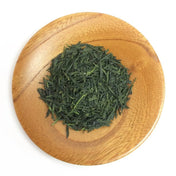Did you know?
Matcha is made by finely grinding tencha leaves, tea leaves that have been shaded for about four weeks, and more importantly, that have been steamed and dried without rolling. The combination of these two techniques along with careful cultivation to produce leaves rich in flavor create the characteristic taste of matcha. 
DON'T BE FOOLED!
The grinding process is often said to be done with stone mills, such as the one pictured to the right (which is a small personal-sized version instead of a commercial version). This is the traditional method and given as a reason for the high price of matcha.
Stone-mill grinding is often used to produce very premium matcha, but the secret that many Western matcha brands don't want you to know is that many many matcha powders are actually produced with other types of high volume grinders including ball mill pulverizers and very cool sounding jet air pulverizers. Newer mills--both stone and otherwise--are often equipped with cooling functions that prevent friction of grinding from producing heat that degrades both flavor and aroma.
SEASONS!
In the end, the type of grinding is actually less important than the harvest season. Spring produces the highest quality leaves with the richest flavor and highest nutritional content. Culinary grade matcha would be produced from Autumn harvested leaves, in which there is a lower overall nutritional content but a higher ratio of antioxidants (making it more bitter). Autumn leaves also tend to be larger and stiffer, producing a grainy texture that would ruin the matcha as a drink.
Other secrets:
- To look for good matcha, look for a deep green color first such as this matcha to the right.
- The inability of the powder to produce a good froth/foam doesn't mean it is low quality, but simply a matcha that doesn't froth, but a matcha that does froth easily is definitely high quality. (Tea masters like to use non-frothing matcha to demonstrate their skill at whisking up froth).
- A very finely ground, high quality matcha will have very little grainy texture.
- If using an insulated tumbler to keep your matcha warm for long periods of time, use a lower temperature such as 50-60C/122-140F degree to make your matcha. If you use a hotter temperature, you'll be continuously extract the flavors, with the bitterness overwhelming the sweetness.
- For over 300 recipes using matcha, take a look at Cookpad.



2 comments
Hello!)
Interesting information! I realized that the ceremonial matcha is harvested in the spring and the culinary matcha is harvested in the autumn( fall).
When is the premium matcha variety harvested?
Hi Ian
When tasting organic versus non organic matcha there is a difference in taste. I prefer the non organic because it taste better. I also read an article about matcha which stated that the fertilizers used with non organic matcha allow the plants to get as much nutrients as possible. The organic fertilizers aren’t as effective providing nutrients to the plant. I have come across a ceremonial organic matcha from Je Ju island. The company is called SeeIn. It is a medium quality matcha to me because it’s color is a dull green. There is a slight yellow color. There is very little bitterness and it makes for a very good daily matcha. It is a very good value for my money. The price is 20.00 for 100 grams bought on Amazon.
Take it Light,
Chris